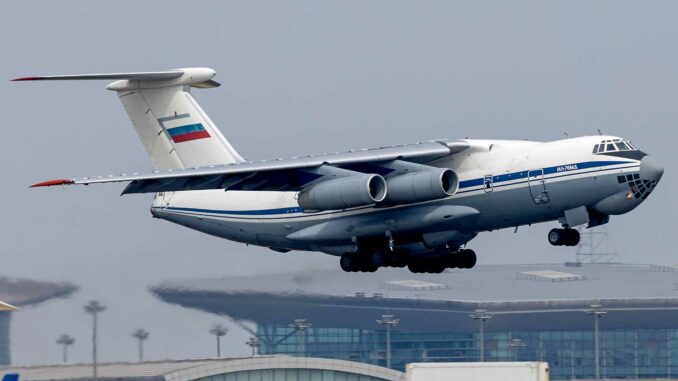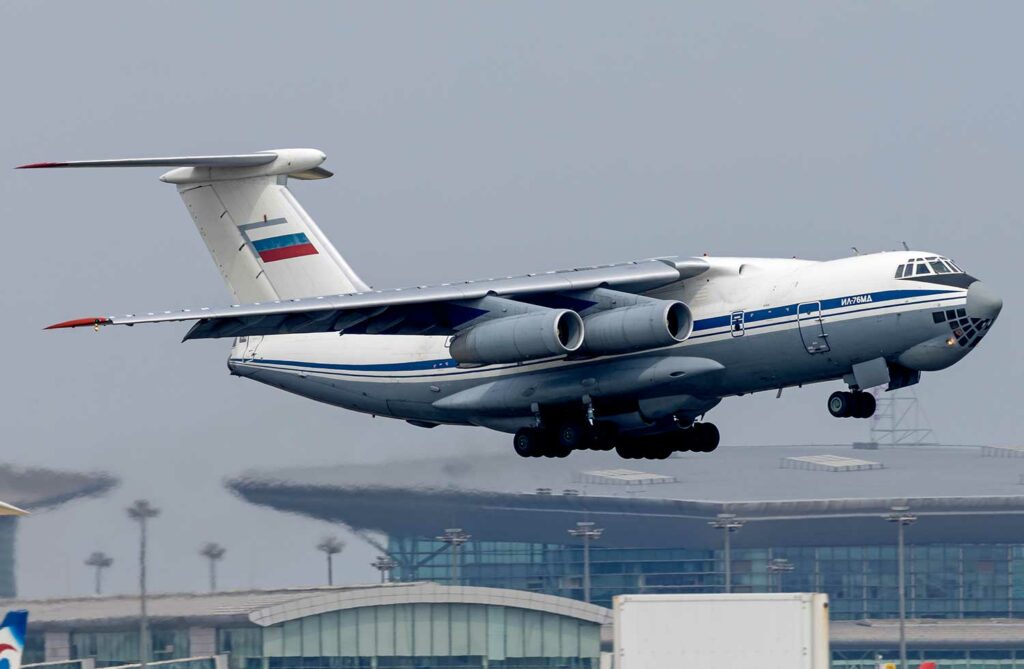
The landing of a Russian cargo plane in Caracas has reignited tensions between Moscow, Washington, and the Maduro regime, against a backdrop of geopolitical calculations.
In summary
An Ilyushin Il-76 registered RA-78765 landed in Caracas after a two-day journey via Armenia, Algeria, Morocco, Senegal, and Mauritania. The aircraft is associated with Aviacon Zitotrans, a Russian carrier under Western sanctions for its links to the military-industrial complex. The episode comes at a time when US-Venezuela relations remain tense over sanctions, oil licenses, and Venezuela’s political calendar. The Il-76 is a large aircraft capable of carrying around 48 tons of cargo and operating on rough runways, making it an ideal logistics vehicle for bulky cargo, technical assistance, or personnel rotations. The nature of the cargo has not been disclosed. Several scenarios are plausible: spare parts, dual-use equipment, technical support, or even the transfer of specialized teams. This arrival reshuffles the regional deck: it lends credibility to the Moscow-Caracas axis, complicates Washington’s calculations, and tests the sanctions mechanisms. In the short term, it may precipitate tighter controls, messages of deterrence, and additional flights.
The trajectory of a cargo plane and what it reveals
Flight RA-78765 was tracked using open sources and identified as an Il-76TD. It took off from the greater Moscow area, then flew towards Western Asia and Northwest Africa before crossing the Eastern Atlantic. The landing in Caracas took place on a Sunday, after approximately 48 hours and several technical stopovers. This route profile avoids European airspace and passes through countries known to occasionally host Russian cargo rotations. The use of an Il-76 is not insignificant: it is one of the pillars of Russian strategic transport, with a cargo hold measuring nearly 18.5 m long, 3.45 m wide, and 3.25 m high (internal dimensions), a sturdy floor, and a rear ramp that facilitates the loading of pallets or light vehicles. Its payload capacity is approximately 48,000 kg (48 t), with a range suitable for intercontinental “hopping” in stages. These characteristics make it a flexible logistical tool, capable of serving degraded airport infrastructure.
The operational usefulness of the Il-76 in Venezuela
The Il-76 can carry standard pallets, generators, engine parts, compact radars, medium-sized communications or electronic warfare equipment, and specialized personnel. It can also evacuate sensitive cargo or equipment returning for heavy maintenance. For Caracas, the benefit is twofold. First, it strengthens the technical resilience of the Venezuelan armed forces equipped with Russian-made equipment (combat aircraft, helicopters, surface-to-air systems), where access to the supply chain is hampered by sanctions. Second, it demonstrates strategic depth: the ability to receive cargo or technical teams at short notice on a high-volume carrier. The choice of a large aircraft allows the flow to be concentrated on a single flight, limiting the diplomatic exposure of multiple rotations.
The sensitive issue of cargo: plausible assumptions
No authority has communicated on the content. Several assumptions, consistent with the format and context, exist. Crates of spare parts for Russian aircraft and helicopters based in Venezuela. Technical assistance modules, test benches, tools, and engineering personnel. Batches of dual-use equipment (communications, countermeasures) deliverable under previous contracts. Finally, a mixed scenario combining cargo and personnel relief. Given its payload of approximately 48 tons, the Il-76 can carry, for example, half a dozen heavy pallets plus teams of technicians, or bulky but relatively light equipment. In the absence of cargo hold images, any categorical statement would be speculative; it is more rigorous to reason by technical compatibility and documented precedents of Russian support in Caracas.
The link with Aviacon Zitotrans and sanctions
Several open sources link the RA-78765 aircraft to Aviacon Zitotrans, a Russian freight company listed on the US SDN list under E.O. 14024. This designation complicates insurability, airport assistance, and third-party services provided to aircraft operated by the company. It also increases the political cost for states that facilitate these flights. The fact that such an aircraft is landing in Caracas indicates that Venezuela and its partners consider the risk of legal and diplomatic repercussions to be acceptable. For Moscow, this is a way of testing the permeability of the sanctions regime in the Western Hemisphere.
The political context of US-Venezuela tensions
Since 2024-2025, the Venezuelan issue has remained framed by an unstable balance: partial easing of sanctions in exchange for political concessions promised to Caracas, followed by readjustments when Washington considers that commitments have not been met. The oil issue—limited licenses, export margins, partnerships with Western companies—serves as leverage. In this context, a visible Russian cargo flight is a signal: Caracas retains extra-regional options, Moscow is demonstrating its logistical projection capabilities, and Washington must factor this into its management of pressures and incentives. Observers note that each US tightening encourages Venezuela to activate its Russian and, potentially, Iranian or Chinese channels.
Moscow’s likely motivations
Several objectives converge. First, to support a political partner that offers symbolic and operational leverage in the Americas. Second, to protect existing defense and maintenance contracts in a market where technological dependence promotes customer loyalty. Finally, creating strategic friction with the United States at a controlled cost: an Il-76 flight does not require heavy resources but has a disproportionate political effect, especially if it occurs during a period of US pressure. There is also a logistical dimension: the Il-76 can quickly transport specific high-value subassemblies, reducing downtime for Venezuelan equipment.
Regional implications and expected reaction
In the short term, the arrival of a Russian heavy lift aircraft may trigger additional vigilance measures in the Caribbean region: flight plan monitoring, enhanced document checks, and diplomatic pressure on states that have hosted stopovers. It may also prompt public messages from the United States reminding of the risks of secondary sanctions. In the medium term, if rotations are repeated, we could see an adaptation of routes and ground service providers, as well as stricter compliance at stopover airports. Neighbors are watching for the ratchet effect: the more routine Russian logistics become, the more resilient the Moscow-Caracas axis appears. Finally, the perception of risk by Western companies involved in energy projects in Venezuela could change, weighing on investment and production.

Technical assessment: what an Il-76 can do in this theater
From a strictly aeronautical standpoint, the Il-76 combines volume, payload, and ruggedness. Its cargo hold can accommodate cubic loads (generators, containers), SPE/PMC air pallets, and equipment with a delicate center of gravity thanks to a floor designed for concentrated loads. The runway length required remains limited for a heavy cargo plane, which is useful if operating conditions in Caracas or on possible secondary airfields become more complex. Its range in mixed cargo configuration allows for a flexible route profile, with stopovers for refueling and quick technical inspections. Compared to Western cargo planes in the same category, the Il-76 prioritizes robustness over pure performance, which is an advantage when a mission must be guaranteed despite imperfect infrastructure.
Scenarios for development: from demonstration to routine
Three trajectories are emerging. The first option is a one-off demonstration: a single flight with high symbolic value, followed by “radio silence.” This would primarily be a political message to Washington. The second option is recurring logistics: infrequent but regular rotations, which establish a “normality” of Russian arrivals and maintain Venezuela’s operational potential. The third option is gradual escalation: an increase in flights and a qualitative evolution of cargo (larger, more specialized), mirrored by a hardening of the US stance and alerts from regional partners. The outcome will depend on three variables: the state of US-Venezuela discussions on sanctions and licenses, the tolerance of stopover countries to the risks of secondary sanctions, and Moscow’s willingness to deploy more visible resources.
Five strategic issues to watch
- Flight frequency and open-source traceability. 2) Confirmed involvement of Aviacon Zitotrans and, where applicable, other Russian operators. 3) US signals: public reminders, investigations, threats of targeted sanctions. 4) The repercussions in the energy sector, where every tension weighs on projects and financing. 5) The stance of Caracas’ allies, particularly political coordination with Moscow on related issues (defense, intelligence, cybersecurity). Each of these items influences Caracas’ ability to maintain its equipment and negotiate with Washington.
The scope of the signal and blind spots
The landing of RA-78765 is neither anecdotal nor decisive on its own. It is a strategic signal: Russia can support the logistics of its Latin American partner despite constraints. But blind spots remain: the details of the cargo, the length of the stopover, the possible presence of support teams, and the scheduling of other rotations. It is precisely in these gray areas that the essentials are at stake: ambiguity maintains the deterrent effect and complicates the opposing response, while leaving each capital the possibility of reframing the message according to the evolution of the balance of power.
War Wings Daily is an independant magazine.